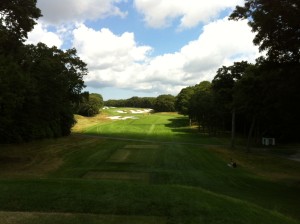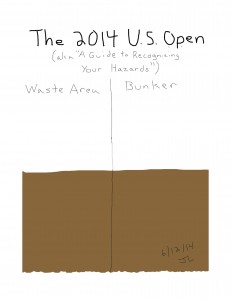 Take your Reds and Greens and Yellows too. It’s The Black we want. Membership dues need not apply. The course is open to all. Fireman. Financiers. Teachers too. The Black cares not what you do or who you are so long as you have the courage to step foot on one of golf’s ultimate exercises in futility. Your wits will be strained. Your legs fatigued. Your soul crushed. Punishing. Unrelenting. Unyielding. The Black will make you question a lot of things. About golf, and about yourself. Is your game good enough to survive 18? Is your heart strong enough to overcome a lover’s rebuke? Is your mind disciplined enough to stay the course, to endure the undulating ups and downs? The only way to find out, the only way to know if you’re up to the test is to play.
Take your Reds and Greens and Yellows too. It’s The Black we want. Membership dues need not apply. The course is open to all. Fireman. Financiers. Teachers too. The Black cares not what you do or who you are so long as you have the courage to step foot on one of golf’s ultimate exercises in futility. Your wits will be strained. Your legs fatigued. Your soul crushed. Punishing. Unrelenting. Unyielding. The Black will make you question a lot of things. About golf, and about yourself. Is your game good enough to survive 18? Is your heart strong enough to overcome a lover’s rebuke? Is your mind disciplined enough to stay the course, to endure the undulating ups and downs? The only way to find out, the only way to know if you’re up to the test is to play.
The Black knows your frustration. The Black hears your words. You are not the first to travel cross the threshold full of high hopes and desires only to have those dreams turn to a nightmare that you cannot escape, that you cannot avoid. The clubhouse is nowhere in sight. The 19th hole an oasis on the horizon. Your playing partners will offer words of encouragement but their support, their empathy, will fall on deaf ears. It’s just you and your thoughts.
The Black will speak to you. But are you willing to listen, are you patient enough to understand? Will you lay up on a par 4? Will you take iron instead of wood? Will you accept the reality that you are nothing more than a transient here on a brief stay and that the hills and trees that block your approach will remain long after your visit has expired. Those rocks. That heather. Reminders that the sports of golf is more nature than nurture. All the lessons in Long Island won’t help you solve the eternal, evolving mystery of The Black.
If you are one of the lucky few to cross that finish line, body and spirit still intact, take a second to look back down the hill, across the fairways and bunkers that fit together like pieces of a puzzle waiting to be solved. That view, that sense of accomplishment regardless of score is one of the greatest satisfactions the game has to offer. The Black knows this, The Black has seen it all before. It knows you’ll come back again, confident that the next time will be different. But the challenge remains. The challenge will not succumb. Bethpage Black exists to outlast.






